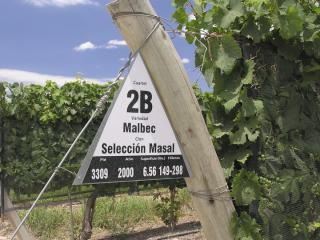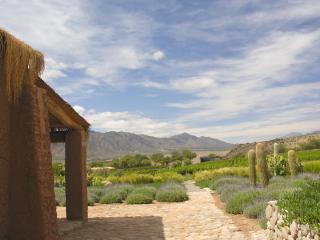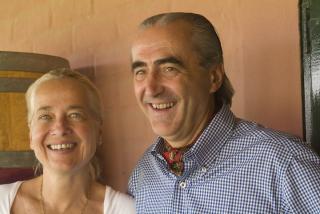Argentina - regional chairman's report
POSTED ON 01/10/2008As the number of Argentinian entries continues to grow at the Decanter World Wine Awards, expectations grow in line along with the high praise that Argentina has been receiving particularly from the Americans press for its reds. In general, the panel was happy with the quality and character of the malbecs, either on their own, or in blends with cabernet sauvignon and other Bordeaux varieties. At the £10 and thereabouts mark, malbec excels as a unique world class product. There are many pricier malbecs too, some beautifully made and starting to show true terroir character but others that try too hard with an excess of oak, extraction and pretentiously heavy bottles. The 2006 vintage was a particular success for malbec and should provide much pleasurable drinking.
 Malbec
Malbec
Where the Argentinian wine industry seems to have mastered varietal expression in malbec, cabernet and red blends with emerging terroir characters in the more elegant and complete styles, there’s still a lack of varietal character among a number of the white wine styles, most notably pinot grigio and sauvignon blanc. The fragrant torrontés is often superior yet on the evidence of this year’s awards, both chardonnay and viognier are making consistent progress. The Valle de Uco and Patagonia are clearly up-and-coming regions and in terms of winemaking, the whites are starting to show less heavy-handed oak that we’ve seen in the past.
What should we be buying from here?
Malbec remains Argentina’s strong suit and the grape variety for which it has justifiably staked a reputation for good value reds whether as pure malbec or in blends. That’s not to ignore cabernet sauvignon and Bordeaux-style blends, especially with cabernet franc and merlot both of which are showing considerable potential in Argentina. In white wines, viognier is showing considerable potential and while there are still too many uninspiring varietals, a welcome and long overdue appearance should help, albeit not substitute a need for more focused varietal definition. Torrontés is Argentina’s great white hope, especially from Salta, and there were some good examples although under £5, it seems difficult for torrontés to shift a mothball-like odour.
What should we leave on the shelf?
White wines are a work-in-progress in Argentina with the sharp, dilute character of pinot grigio making it one of the least inspiring varietals in the Argentinian panply of whites. Sauvignon blanc needs more varietal expression. There were few sparkling wines entered, which is a shame because there are some good ones and the small number of rosés that were entered were also a letdown. Among the red wines, pinot noir is lacking in freshness and incomplete with little more than a tutti frutti dry red character, while syrah, which surely could be a lot better, suffers from a general lack of elegance and freshness. Overoaking of reds remains a common problem masking what should be a pure, bright fruit quality. And there are too many hefty, heavyweight bottles suggesting lack of confidence and trying too hard.
What should we keep an eye on?
We should continue to keep a firm eye on malbec, in particular good value malbec in the £10 region as it’s not yet reached the stage of trying too hard, a factor that mars what would otherwise be a terrific wine, and that’s not to detract from those who are getting it right. The high Uco Valley and Patagonia down south are both regions to watch for their bright and elegant reds and whites, while Salta remains the province to beat when it comes to torrontés. A number of wineries are making strides with tempranillo, either on its own or in blends, so the Spanish variety, along with the occasional interesting bonarda, is often a good bet where the producer has singled out the varietal for quality treatment.
Profiles
Caro
Argentina Red Blend Over £10
2005 Caro, Mendoza, Argentina
Urban myths often contain a grain of truth and the one about Caro, the Argentinian joint venture between Nicolas Catena and Baron Eric de Rothschild, is at least amusing, whether apocryphal or not. After Baron Eric de Rothschild fell in love with Catena’s old-fashioned winery at Escorihuela, which also houses the fine restaurant Francis Mallman 1884, he accepted Nicolas Catena’s offer to sell part of the old building, dating from 1884, for the production of their joint venture wine. But what would they call it? The name Caro was apparently chosen not just because it means ‘dear’ as in loved one, but also ‘dear’ as in pricey. It’s hard to know how big or small a pinch of salt is to be taken with this story, but you can readily imagine the two wily producers having a good laugh over a glass of Lafite at such a clever double entendre.
After overseeing a partial renovation of the brick-built buildings with their impressive brick-arch ornamented walls and high ceilings, Estela Perinetti, an accomplished flamenco dancer as well as skilled winemaker, was charged with making the wine so dear to the hearts and bank balances of Nicolas Catena and the Baron. And the results have been excellent, the 2002 rich in cherry and cassis fruit like a supercharged Médoc, the 2005 a worthy DWWA trophy winner. The source of the malbec and cabernet sauvignon for Caro is 12 vineyards from eight locations based on the areas of Vistalba and Agrelo, with between 3,500 and 4,800 cases made while the majority of the material goes into a second wine, Amancaya, reaching around 30,000 cases last year.
‘Caro was conceived nine years ago and as time goes on, I become more and more convinced that malbec and cabernet sauvignon are complementary’, says Estela. ‘The typicity of cabernet sauvignon changes in different locations within Mendoza but with our extremes of climate, malbec changes even more dramatically from one area to the other’. She finds the 2005 in particular ‘classic, beautifully concentrated and balanced’. Since Estela recently welcomed a newcomer to the family fold, the winemaking won’t receive any less attention than when she had to take a back seat, but the flamenco shoes are definitely back on as she olés her way across the dance floor. A new angle on winemaker dinners perhaps?
Colomé
Argentina Dry Aromatic White Under £10
2007 Bodega Colomé, Torrontes, Calchaqui Valley, Salta, Argentina
 Colome
Colome
It’s a long way to Cafayate, and a good deal further to Colomé. As you take the long and winding road from Cafayate towards the valley where the winery and hotel complex of Colomé sits, you pass through a series of phallic, upright cacti cardones whose silver tips look as though they’ve been dipped in silver paint. A final bone-crunching assault before you head down the wide open valley towards a splash of green nestling up against high mountains takes you to Colomé itself, an improbable green oasis of luxury in the middle of arid desert.
If ever you’re fortunate enough to find yourself at Colomé, you can understand why Donald Hess fell for this little slice of Andean mountain heaven bought from Raul Davilos. Isolated as it is at 2,200 metres, Colomé is at once a winery, luxury hotel and working 40,000 hectare estancia adjacent to a village of 400-odd hardy locals with church and community centre. 100-odd villagers work on the estancia, where the old 1831 adobe winery still stands next to a modern 1.3 million litre winery and the adobe-built ochre walls, arches and red pantiled roofs of a hacienda-style hotel that blends seamlessly into its surroundings.
Having made a fortune from Walter, the mineral water brand he sold to Coca-Cola in 2002, Hess is a proven water diviner who decided that Mendoza was too crowded to house his ambitions of owning an Argentinian winery. Irrigated from the nearby river, the 70 hectares of clay soil vineyards were mostly planted in 2001 to malbec, with a touch of cabernet sauvignon, tannat, petit verdot, touriga nacional and syrah, and, all jumbled together in the same vineyard, four hectares on their own roots of pre-phylloxera 19th century pergola-trained vines of malbec, cabernet sauvignon, torrontés, sauvignonasse, tintorera and criolla.
In addition to the vineyards at Colomé, there are three further sources of grapes planted at 1900, 2,600 and 3,000 metres. Taking advantage of Colomé’s isolation to produce grapes on biodynamic lines, winemaker Thibaut Delmotte, from Burgundy, works with viticulturalist, Xavier Grane and Randle Johnson from Hess Collection in California to produce powerful malbecs, but the surprise perhaps is the quality of the torrontés. It shouldn’t be. Argentina’s signature white variety is at its best in this region, and as Colomé shows, produces an intensely fragrant, headily exotic dry white of excellent concentration.
Fabre Montmayou
Argentina Red Single Varietals Under £10
2006 Domaine Vistalba, Viñalba Reserva Malbec, Luján de Cuyo, Mendoza, Argentina
 Herve and Diane Joyaux
Herve and Diane Joyaux
First impressions are lasting impressions as they say and on my first trip to Argentina in 1998, a first stop at Fabre Montmayou in Luján de Cuyo’s Vistalba sub-district made a lasting impression. I was immediately struck by the fact that such an urbane and handsome couple as Hervé and Diane Joyaux should have turned their backs on Bordeaux to settle as apparently provincial a backwater as Mendoza. I was struck too by the century-old vineyards with babbling brook alongside, by the wide open spaces and incomparable views of the snow-capped Andes at 1150 metres. When Hervé explained just why after years of searching for right spot he thought Mendoza offered the perfect conditions for wine production, I realised it wasn’t so strange after all. In fact, adapting to such a hospitable country with its stunning scenery was their holy grail.
Hervé’s great grandfather owned a property in the Graves and his grandfather in the Premières Côtes de Bordeaux. After his father sold the two properties, Hervé, who first worked for Bordeaux négociant, spent several months in Chile in 1991 in search of a property to buy. He found nothing that would justify uprooting himself 10,000 miles but on crossing the Andes into Mendoza, he was bowled over by the potential of malbec and decided to make the move with his wife Diane, a former PR with Möet & Chandon in Germany, and children. After studying the qualities of each growing area, he decided to buy exclusively old vineyards in two different regions where the soil and climate would offer the best character and individual expression for each variety.
Since that time, I have visited Fabre Montmayou again, this time with a wife who shares Hervé and Diane’s passion for horses, one of which, on one of their trips across the Andes on horseback, reared and fell backwards, almost killing Hervé in the process. Today, their Domaine Vistalba owns three wineries, two located in Mendoza region and the third in the Rio Negro Valley in Patagonia where the clear air, sunlit days and nights contribute to wines of piercing clarity and sensuality. Their wines have got better and better thanks to Hervé and Diane’s vision and commitment to malbec and their experience with the variety. Their Grand Vin is one of Argentina’s best blends and the seductively rich and spicy, black-fruited 2006 Viñalba Malbec Reserva grown in the foothills of the Andes Mountains is a magnificent example of its kind, justifying all the hard decisions and investments made since Hervé and Diane first set eyes on Mendoza.
Nieto Senetiner
Argentina Red Single Varietals Over £10
2004 Bodegas Nieto Senetiner, Cadus Malbec Single Vineyard, Mendoza, Argentina
I suspect that Nieto Senetiner’s chief winemaker is a self-effacing kind of guy because although he has worked at Nieto for 17 years and is apparently well-known locally, he’s not particularly high profile. Far from it. Roberto lists his hobbies as reading wine books, history and enjoying quiet weekends in small mountain little towns together with his wife and his son. He’s also a member of the undoubtedly prestigious Argentinian Academy of Vines and Wines, director of an MBA on ‘Strategic Management of Viticulture’, and teaches at the university. Interesting as all this makes him, what’s most interesting about Roberto from any wine consumer’s viewpoint is that he makes a serious malbec: the 2004 Cadus Nieto Senetiner Malbec, a rich yet elegant, stylish red and black fruited malbec that wears its 24 months in French oak lightly.
Dating back to 1888, Bodegas Nieto Senetiner was founded by Italian immigrants in La Carrodilla, Luján de Cuyo, in Mendoza. In the hands of different families during the early decades of the last century, the winery developed by producing wines and selling them on the local market, mostly in bulk. In 1969, the Nieto Senetiner family acquired the vineyards and winery and set about modernizing and expanding the operation. Since 1996, the first vintage of Cadus, Alberto Antonini, the Italian wine consultant, has been part of winemaking team. More recently, in 1998, the winery was purchased by the Perez Companc Family, founders of the Perez Companc Family Group, one of the largest business corporations in Argentina. The acquisition resulted in the boutique winery Vistalba, the top end winery responsible for Nieto’s Cadus and Don Nicanor wines
Nieto Senetiner owns 352 hectares of vineyards, located in Luján de Cuyo’s sub-districts of Carrodilla, Vistalba and Agrelo, growing malbec, along with cabernet sauvignon, merlot, shiraz, bonarda, barbera and torrontés and chardonnay. In the heart of Luján, Nieto prides itself on the quality of its vineyards and optimal conditions for malbec. Made from 35-year-old vines grown at 1,100 metres on the traditional pergola system in Agrelo, Cadus, from the ancient Latin word for ‘barrel’, is the quintessential expression of Nieto’s malbec, intensely flavoured and concentrated and at the same time as pure as malbec gets.

